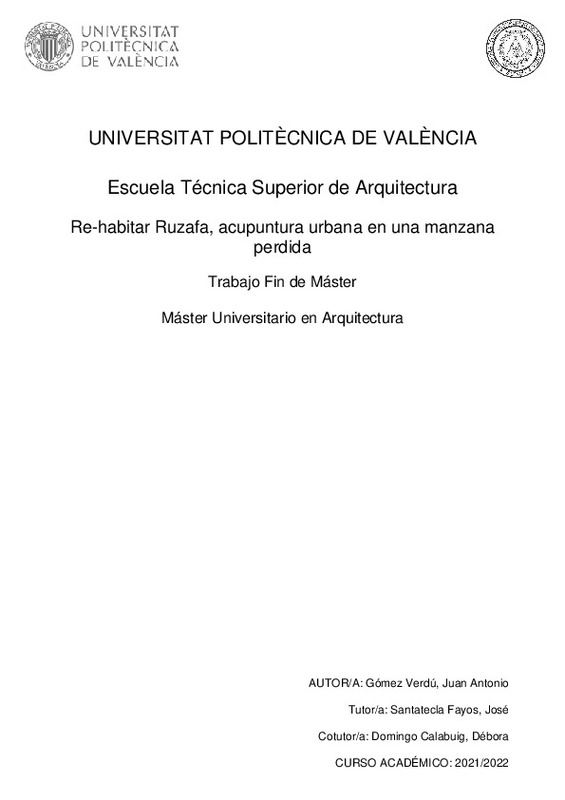|
Resumen:
|
[ES] Durante los años 70 y 80 Ruzafa se encontraba en una situación de declive urbanístico, social y económico. Artistas y creativos en los 90 se vieron atraídos por las características del barrio así como los bajos ...[+]
[ES] Durante los años 70 y 80 Ruzafa se encontraba en una situación de declive urbanístico, social y económico. Artistas y creativos en los 90 se vieron atraídos por las características del barrio así como los bajos alquileres, apostando por él y empezando un periodo de revitalización. Ruzafa desde entonces consolida su identidad dentro de la ciudad de Valencia y se crea un sentimiento de pertenencia al barrio.
Amenazas como la gentrificación, el precio abusivo de las viviendas, la aparición de negocios franquicia y la superpoblación de locales de consumo ha acabado con el comercio de proximidad y con la variedad de servicios en los centros históricos de ciudades y barrios y el caso de Ruzafa no es diferente.
El espacio libre existente en el centro de las ciudades no puede dar respuesta a la creciente necesidad de vivienda, equipamientos y espacio público. Es necesario tratar de re-habitar espacios existentes en los centros de ciudades y aprender a vivirlos de otra manera. Nuevas estrategias y lineas de pensamiento basadas en el Km0 o la proximidad y en la cultura vernácula y de cercanía pretenden hacer frente a este problema
Se propone por tanto una intervención a diferentes escalas para cohesionar el barrio y tomar los primeros pasos para la estabilidad del mismo. Generar un eje verde que cosa transversalmente el barrio con el Parque Central y el Parque del Rio Turia, generando recorridos peatonales libres de tráfico y proyectando un equipamiento con usos mixtos de vivienda, taller y escuela de arte que permita fomentar un espacio urbano sostenible, democrático y de calidad.
La propuesta intenta sin embargo ir un poco más allá, imagina y da forma a las maneras de vivir que el barrio reivindica integrando términos nuevos como re-habitar, habitar de otra manera, o micropolis que en oposición a metrópolis define una ciudad compuesta y diseñada desde los espacios a escala humana.
[-]
[EN] Back in the 70s and 80s Ruzafa was in a social, urban and economic
decline. Artists and creatives in the 90s were attracted by the
features of the neighbourhood as well as the low rentals, betting
for it and starting ...[+]
[EN] Back in the 70s and 80s Ruzafa was in a social, urban and economic
decline. Artists and creatives in the 90s were attracted by the
features of the neighbourhood as well as the low rentals, betting
for it and starting to revitalise it. From the early 90s Ruzafa
consolidates its identity inside of the city of Valencia generating in its inhabitants a feeling of membership.
Threats like gentrification, abusive rent costs, surging of franchise business and and tertiary has attacked directly local businesses and the variety of services in historical city centres and
Ruzafa’s case is not different.
Existing free space in city centres can’t provide with an answer the increasing need for living, public buildings and public
space. It is needed thus to Re-Inhabit existing spaces and learn
to live them in a different way. New strategies and lines of
thought based on Km0 or local businesses and vernacular architecture intend to face these problems.
A different scaled intervention is proposed in order to unite
the neighbourhood and take the first steps to provide stability
to it. Creating a green corridor that sews the transversely the
neighbourhood with “Parque Central” and “Parque del Rio Turia”,
generating pedestrian friendly paths free of traffic and designing mix-used buildings that promote a healthy, sustainable and
democratic urban space.
The proposal tries to go further, imagining and shaping the ways
of living of those who already inhabit the neighbourhood, integrating concepts as re-inhabit or inhabit in a different way or
micropolis which opposes to metropolis and defines a city composed and designed from the human scale spaces.
[-]
|







